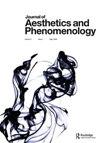When Poetry and Phenomenology Collide
IF 0.2
0 PHILOSOPHY
引用次数: 2
Abstract
Abstract In recent years several scholars have wrestled with the term “poetic thought,” suggesting in various ways there is something distinctive about the nature of meaning as it occurs/unfolds through poetry. In this paper I suggest, in part following the lead of Simon Jarvis, that one of the most fruitful lines of inquiry for exploring this idea lies in a consideration of poetic works through the lens of Heidegger’s early phenomenology. Specifically, I argue that one of the keys to understanding poetic thought lies in a flaw within Heidegger’s ontological divisions between substances, equipment and Dasein, as presented in Being and Time (1927). Through an analysis of three poems by Frank O'Hara, I argue poetry that examines and represents the physical world presents a problem for Heidegger when he suggests equipment in the world must necessarily “withdraw” in order for us to engage with it authentically. To address this, the term environment-at-hand is introduced to describe the relationship between artists and the surrounding environments used for their work. Poetic thought is here conceived as the point where poetry and phenomenology collide; where poetry reflects and enacts the fact that humans are inherently engaged meaning-makers. In this way poetry does not only show us new ways of looking at the world, which it surely does, but it can help us understand the nature of being itself.当诗歌与现象学碰撞
近年来,一些学者对“诗意思想”这个术语进行了争论,他们以不同的方式提出,在诗歌中发生/展开的意义本质上有一些独特的东西。在本文中,我部分追随西蒙·贾维斯(Simon Jarvis)的观点,认为探索这一理念最富有成效的研究路线之一在于通过海德格尔早期现象学的镜头来考虑诗歌作品。具体来说,我认为理解诗歌思想的关键之一在于海德格尔在物质、设备和此在之间的本体论划分中的一个缺陷,正如《存在与时间》(1927)所呈现的那样。通过对弗兰克·奥哈拉的三首诗的分析,我认为检视和表现物质世界的诗歌给海德格尔提出了一个问题,他认为世界上的设备必须“撤回”,以便我们真实地参与其中。为了解决这个问题,我们引入了“手边环境”(environment-at-hand)一词来描述艺术家与其作品所使用的周围环境之间的关系。诗的思想在这里被认为是诗与现象学的碰撞点;诗歌反映并体现了人类天生就是意义创造者这一事实。通过这种方式,诗歌不仅向我们展示了观察世界的新方法,它确实做到了,而且还能帮助我们理解存在本身的本质。
本文章由计算机程序翻译,如有差异,请以英文原文为准。
求助全文
约1分钟内获得全文
求助全文

 求助内容:
求助内容: 应助结果提醒方式:
应助结果提醒方式:


